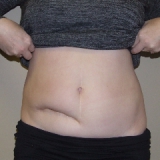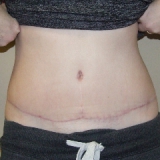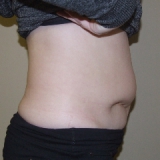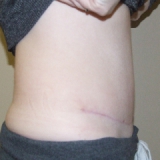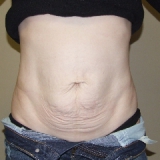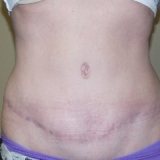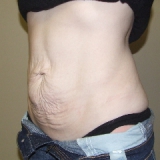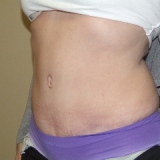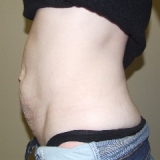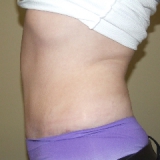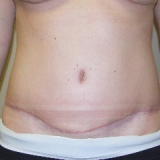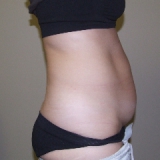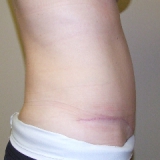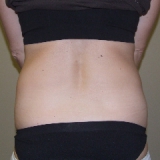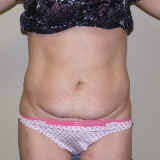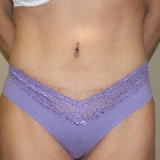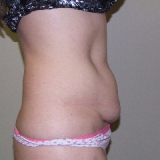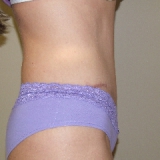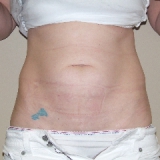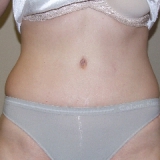Tummy Tuck (Abdominoplasty) in Barrie, Ontario
An abdominoplasty (also known as a Tummy Tuck) is a popular form of cosmetic surgery for people wishing to regain a flatter abdomen.
Abdominoplasty is a cosmetic surgical procedure designed to flatten the abdominal area by removing excess skin and fat produced due to decreased skin elasticity. The tummy tuck surgery tightens the muscles of the abdominal wall, correcting sagging abdominal skin.. It is an excellent procedure to correct excess abdominal skin and repair muscle laxity following childbirth or as a result of significant fluctuations in weight.
How is Tummy Tuck Surgery performed?
Our board-certified plastic surgeon in Barrie, Ontario, Dr. Kenneth Dickie performs a full abdominoplasty (complete tummy tuck) under a general anaesthetic. The procedure takes 1.5 to 3 hours, depending on the individual patient. A mini-abdominoplasty (also know as mini tummy tuck) can be performed under a local anaesthetic (with sedation). Tummy tucks are typically performed as outpatient procedure; however, individual circumstances and extent of surgery may require an overnight stay in our private surgical facility at the Royal Centre of Plastic Surgery in Barrie.
Dr. Dickie will make a horizontal incision in the area immediately above the pubic bone (bikini line) during your tummy tuck surgery. The length and shape of the incision will be determined by the degree of correction necessary. Excess skin is removed and the weakened abdominal muscles are sutured together resulting in a smooth, tight abdominal wall. If it is necessary to remove excess fat as well, liposuction may be used to achieve the desired correction. A small incision around the navel will be necessary to re-position the belly button.
Who is a good candidate for Tummy Tuck Surgery?
You may be considered a good candidate for tummy tuck if you are physically healthy and have stable weight with a body mass index no greater than 30. Those who plan to lose significant amount of weight should wait until their weight is stabilized. Patients considering abdominoplasty should have realistic expectations regarding the outcome of their surgery. For example, a previous abdominal surgery with significant scar tissue, might limit the results of tummy tuck procedure and future pregnancies can also have a negative impact.
Recovery from Tummy Tuck Surgery
After the surgery, Dr. Dickie applies dressings to the incision of tummy tuck patients for proper healing. You will wear a removable compression garment in order to minimize swelling while supporting your abdomen during your two weeks healing process. Dr. Dickie may also place a temporary drainage tube under the skin to drain any excess fluids that would otherwise collect around your tummy tuck scar. Taking oral pain medication may be necessary. Typically tummy tuck patients can return to work after about two weeks. However, strenuous activity must be avoided for four to six weeks. After this time, you should be standing tall and confident with your newly tightened muscles and a slimmer profile. Your tummy tuck scars will take approximately three to twelve months to fade and flatten.
What is the cost of Abdominoplasty Procedures in Ontario?
Tummy Tuck Cost in Barrie
The fees for tummy tucks (abdominoplasty) by Dr Dickie include preoperative testing, operating room, anesthesiologist, supplies, medications, dressings, surgeon’s fee, recovery room, overnight stay, and office checkups for 12 months, and the cost depends upon which surgical facility is used. Contact us to get your estimate of tummy tuck cost.
How to Find the Right Plastic Surgeon for the Desired Cosmetic Procedures?
One can find plastic surgeons offering lower fees for tummy tuck procedures. Although lower fees do not necessarily mean that the surgeon is not experienced, there are several questions to which prospective abdominoplasty patients must learn the answers, since this is considered a major surgery:
- Is the surgeon certified by The Canadian Society of Plastic Surgeons or The American Society of Plastic Surgeons?
- Does the surgeon have considerable experience with the surgery?
- Is the surgical facility fully accredited for general anesthesia?
- Will there be an M.D. Anesthesiologist present?
- Will the surgeon be doing the surgery himself/herself?
- Can you be sure the surgeon is not just supervising trainees?
- Does the quoted fee include everything listed above?
You want to be certain the answer is yes to all of these before deciding.
All cosmetic surgery is prepaid, but various financing options are available. It is not appropriate for health insurance to cover cosmetic procedures, and abdominoplasty is almost always an elective cosmetic surgery. In some rare situations, such as after massive weight loss, or presence of an abdominal hernia or similar problem, health insurance assistance may be appropriate, and only in such a case would Dr. Dickie submit abdominoplasty to a patient’s insurance company.
Tummy Tuck Consultation with Board-Certified Plastic Surgeon in Bariie
Contact the Royal Centre of Plastic Surgery for more information on abdominoplasty (tummy tuck) and other possible cosmetic enhancements that you might be considering and to schedule an in-depth consultation with Dr. Dickie. Our state-of-the-art private setting for surgical and comsetic procedures is located in Barrie, Ontario, only a one-hour drive from Toronto.
Let us help you achieve your desired look. We are committed to helping you look and feel great.
Frequently Asked Questions About Tummy Tuck Surgery
Can exercise tighten the skin without abdominoplasty?
Unfortunately no. Exercise is good for the mind and body in general, and toning the muscles can help fill out loose skin in the vicinity. By suppressing the appetite, and by slightly increasing the metabolism, exercise can assist weight loss. But there is no such thing as a “spot” exercise, to make the body lose weight in a certain area, nor to make the skin tighter. Exercise can increase muscle bulk, and that in turn can make skin look tighter in some areas, but exercise cannot tighten the loose abdominal skin. To date, only surgery can accomplish that.
Is abdominoplasty a good way to lose weight?
No, abdominoplasty is not a good method for weight loss. Not only is it less effective for people who are obese, but also the results are less than ideal, and there are increased risks for the significantly overweight person. The best candidates are those who have attained their correct body weight, and yet still have the abdominal problems which do not respond to further weight loss or exercise. After a consultation examination, Dr. Dickie often prescribes a diet program for overweight patients as preparation for abdominoplasty.
Does abdominoplasty take care of cellulite?
There is nothing mystical or special about “cellulite”, it is just fat, but it is fat located just under the skin, making a rippled look that is quite apparent. Abdominoplasty removes some of this cellulite fat also, but it is difficult to eliminate entirely. Weight loss by dieting is the best way. Sometimes, these skin irregularities can become more noticeable after abdominoplasty.
Does abdominoplasty take care of stretch marks?
Stretch marks are scars. They are produced by distension of the skin, but only in situations in which there are various hormones circulating, as in pregnancy and puberty. Those stretch marks located on the lower abdomen will be removed with the extra skin. Those located on the upper abdomen will be shifted downward as the skin is brought downward. The stretch marks that remain are tightened and smoothed out somewhat.
Will abdominoplasty tighten up loose skin?
Yes, that is one of the main purposes of abdominoplasty.
What are the techniques of abdominoplasty or tummy tuck surgery?
The excessive loose skin of the lower abdomen is removed, and the remaining skin is repositioned, stretched smooth, and tightened. Lower stretch marks are removed, and upper stretch marks are lowered down. Any low fat roll is removed or redistributed. The muscles are tightened and cinched together to accentuate the waistline. Sometimes liposuction is used as an adjunct procedure along with the abdominoplasty. Frequently, female patients may choose to have simultaneous breast enlargement via the navel leaving no additional scars, (or by other methods).
Where are the incision scars after abdominoplasty?
There is always a scar around the navel. There is almost always a low horizontal scar across the lower abdomen just above the hairline. Sometimes there is also a short vertical scar above the pubic area. A person whose problem is only laxity of the muscles, rather than skin excess, may be able to have endoscopic abdominoplasty, leaving only the scar at the navel and a short scar above the pubic hairline.
Can the problems come back after abdominoplasty?
Fat cannot come back unless one gains weight again, in which case all body areas will share in the weight gain. However, after abdominoplasty the treated area has a permanently decreased capacity for additional fat, because so many of the fat cells have simply been removed. But there are still fat cells present, so some gain in that area is to be expected with weight gain. Skin stretches with the passage of time, and so as the years go by there will be more skin, and for the same reason the muscles will gradually stretch out again. Nevertheless, a better contour after surgery is in a sense permanent, in that no matter what the person’s age, the benefits remain.
Is abdominoplasty surgery painful?
Yes, moderately so, because of the tightening of the muscles that is almost always included. All the patients are given strong narcotic pills to take at home, and limit their activities accordingly.
What is the recovery period after abdominoplasty?
Tummy tuck recovery time depends on the individual, but usually follows a general pattern. For the first five to seven days, the patients take fairly strong pain medicine, usually a mild narcotic. During this time they generally stay at home, and they cannot drive a car or operate machinery. Near the one-week mark, when they are on milder medicine, they can start light exercise, such as walking, treadmill, stationary bike, but not impact exercises like running or aerobics. The second week, weights or exercise machines can be added, and then after three weeks, running and aerobics can be done. The point at which work can be resumed depends upon how the work activities fit into the progression described above, and this is individualized. Dr. Dickie often recommends that an elastic binder be worn for varying lengths of time.

